Judging by the events of this episode, and the anime’s overall pace up til this point, I’m incredulous that we’ll get a satisfying conclusion by the season’s end. With that said, however, I’m enjoying the individual episodes every single week. I just wonder if this series could really be as short as it’s purported to be. Ah well, enough about this — let’s get to the analysis.
“Get thee to a nunnery!”
The theme of sexual exploitation dominates much of this week’s episode. When Rikiga pays a visit to Dogkeeper, Dogkeeper accuses the man of profiting off of women’s bodies. Rikiga shrugs off the girl’s charges, however, countering with an insinuation that she is not so innocent herself:
“You’re no better. I heard that you’re a runner, smuggling scraps of food and clothing from the correctional facility to the West District. … You probably had to bribe a janitor to make it work. Right?”
Dogkeeper’s facial expression during this scene says everything we need to know.
A little later in the anime, Shion feels the desperate need to tell Nezumi about the parasite bees afflicting the residents of No.6. This, however, requires Shion to pay a visit to the theater where Nezumi assumes the role of Eve. Shion is hesitant to attend the play, however. Although he wants to know Nezumi better, he’s also scared of what he might learn. Why might that be?
When we finally enter the theater with Shion and Rikiga, we see a very truncated version of Act III, Scene I of Shakespeare’s “Hamlet.” The actor playing Hamlet immediately levels an accusatory question at Ophelia, played by Nezumi/Eve: “Are you honest? Are you fair?” Keeping in mind the theme of sexual exploitation, we sit here and wonder, alongside Shion, whether or not the androgynously beautiful Nezumi has remained “honest” and “fair.” Or has he also corrupted himself to survive? After all, his name is ‘Nezumi,’ i.e. rat. While we see positive portrayals for the mice in the anime, rat has quite a negative connotation. Rats have long symbolized decay and corruption in art.
Hamlet later rejects Ophelia, ordering the poor maiden to get to a “nunnery.” The brilliance of the play “Hamlet” is in how Shakespeare managed to employ a double meaning into almost every line he wrote. ‘Nunnery,’ as we commonly understand the word, is a place for nuns (obviously). In a way, therefore, Hamlet is telling Ophelia to escape now before misfortune befalls her. After all, Hamlet’s after vengeance and he doesn’t want Ophelia to be caught in the situation. But just a short while ago, in the same scene, Hamlet was questioning Ophelia’s chastity. You’ll be interested in finding out, then, that ‘nunnery’ was a slang word for a brothel. Likewise, ‘nun’ was slang word for a prostitute.
Mise en abyme
We have established, then, that Hamlet and Orphelia represent Shion and Nezumi respectively. Hamlet/Shion questions Orphelia’s/Nezumi’s chastity and then the former retracts his love for the latter. If the play is a microcosm of the Shion-Nezumi relationship dynamic, we should also examine the play from Nezumi’s perspective. Ophelia is heartbroken after Hamlet’s apparent rejection of her. We can then interpret this scene as Nezumi’s fear of Shion’s rejection. Although he’ll say that the theater is too dangerous for someone like Shion to attend, can we really take Nezumi’s words at face value? Or, like Shakepeare’s play, do the words have a double meaning? Maybe Nezumi is just afraid of how Shion might react if he learns more about Nezumi.
“To be, or not to be…?”
This is the infamous line from “Hamlet.” People have interpreted these six words in a multitude of ways, but I think the one meaning most applicable to “No.6” is Hamlet asking himself whether or not he should commit suicide. For Nezumi, he only understands one thing in the harsh, brutal environment of the slums: live or be killed. To grow soft — to love another person — is to die and, essentially, to commit suicide.
When Nezumi and Shion share a tender moment near the end of the episode, Shion has a hand around Nezumi’s neck. Nezumi reacts negatively to this physical contact, flabbergasted that he could allow himself to be so vulnerable around his friend:
“I couldn’t avoid his attack. I allowed him to hit a pressure point.”
Nezumi sounds as if his own life is in danger. How could he not, however? “To be or not to be” loved? From the life Nezumi has lived, all he knows is that love can get him killed.
Claudius and Polonius
Hamlet and Ophelia weren’t alone in their conversation; Claudius and Polonius were hiding nearby, eavesdropping on the pair. Besides Shion and Nezumi, however, do we know anyone else at the play? The only answer is Rikiga. I don’t know if there’s any possible connection between Rikiga and the duplicitous villains in “Hamlet,” but I certainly do not find him trustworthy. After all, he makes a living by pimping women to No.6 officials.
The dance
Nezumi, gleeful that the bee pestilence could possibly destroy No.6 once and for all, pulls Shion up to his feet and dances with him. The two are initially indoors, but as they dance, the setting around them suddenly changes: we are now above surface, in the dead and broken world outside No.6. I love the visual narrative in this scene.
One of the first things we see are railroad tracks. By the looks of the tracks, however, it’s clear that they haven’t seen life in a long time. We soon see Nezumi and Shion dancing again, this time amongst a playground in ruins.
The post-apocalyptic imagery here reminds me of a scene in “Terminator 2:”
We then cut to a shot of a broken watch, suggesting that time has stopped for the world outside No.6.
Nezumi and Shion continue to dance, however, and their movements seem to stir up life in this dead world where time has stopped. We see a doll drowning in a shallow pool of water, an obvious symbolism for death.


Unfortunately, the ripples are much easier to see in motion.
As the pair dances, a wind picks up and causes the water to ripple softly. The ripples break the image of the doll ever so slightly; although the doll itself remains submerged in the water, its image comes to life albeit briefly.
The wind then begins to sweep up a storm of leaves around the pair. Although the leaves come from a dried-out husk of a tree, the floating leaves suggest that change is afoot in the world of “No.6.” What sort of change? In such a harsh world, perhaps the only change anyone really knows is death. After all, death is the ultimate and irreversible change. The budding relationship between Nezumi and Shion, on the other hand, re-introduces love and trust to the dead world. There’s now change that doesn’t involve death.
Change, however, doesn’t occur overnight, so even when the leaves are blowing across the field, we have to keep in mind that the leaves themselves are still dead. Although Nezumi and Shion are closer than ever, we also see that Nezumi is suspicious and scared; he isn’t ready to trust his life to anyone but himself just quite yet.
Unanswered questions
• What is the connection between Safu and Nezumi’s simultaneous bouts of unconsciousness? We are only given a few tenuous clues. The two are both submerged in the world of art when they suddenly pass out. Safu marvels over a stained glass window of bees (why a stained glass window anyway — is this a biblical connection?) while Nezumi is acting on stage.
Could there be an emotional link? For possibly the first time in Safu’s life, she forms a connection that amounts to more than the “nuts and bolts,” so to speak, of the object in question. Her facial expression before the stained glass window brings to mind someone undergoing religious or perhaps spiritual ecstasy. In contrast, a marked change in behavior afflicts Nezumi when he notices Shion in attendance.
Of course, there’s also the disembodied voice and Nezumi’s bizarre visions of a field of tall grass and blue skies suddenly blotted out by a swarm of murderous bees. We then see a young Nezumi sinking into black tar. Has God finally decided to rain pestilence down upon the world, especially the city of No.6? Will Nezumi be punished too unless he accepts Shion’s help?
On the other hand, Safu saw ‘nezumi’ — it’s not entirely clear whether or not she saw Nezumi or a nezumi. It’s interesting, however, that she immediately thinks back to Shion and the rat chasing incident in episode two.
• We also get hints this week that the pestilence of bees is something outside of No.6’s control. Is there a rhyme or reason to who the disease attacks next? The characters in the anime call it a parasite, after all. When a nurse insults the elders under her care, we can understand why she might be punished, but why Shion, a character who seems almost too pure at times?
• We saw some brief glimpses of No.5 in this episode. On the surface, its aesthetics (reminds me of Sydney, Australia) seem to differ little from No.6.
• Although the Safu bits appear to mostly re-inforce the idea that Safu’s different from other people, it’s interesting to see that the inhabitants of No.5 do find her strange. Is Safu unique or is No.5 fundamentally different from No.6?
Safu’s education now includes the arts. We hear that she’s done a (poor) report on a painting by Botticelli’s “Venus.” We also get to see her read a (very dry — practically prose) poem in class.
According to Shion in episode three, inhabitants of No.6 are discouraged from reading the classic. No.5, from what we’ve seen, doesn’t seem to share the same problem. Is this a significant difference or merely an inconsistency in the story?
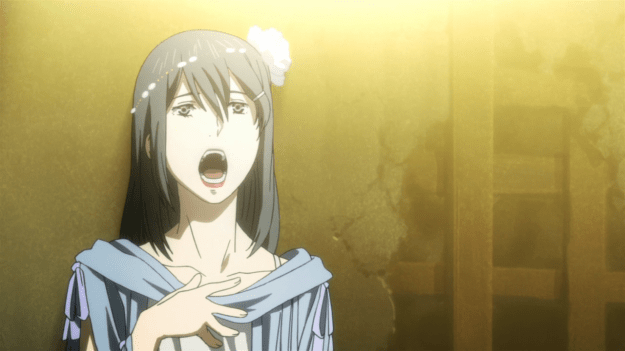

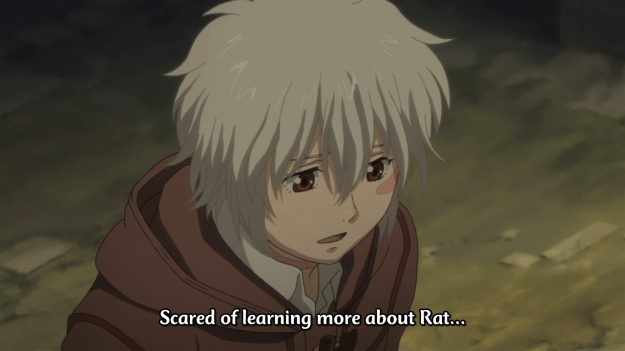
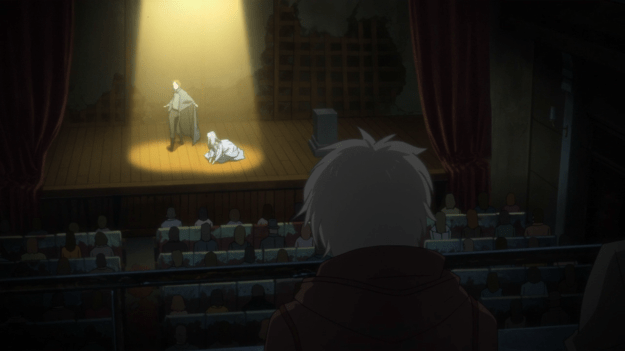



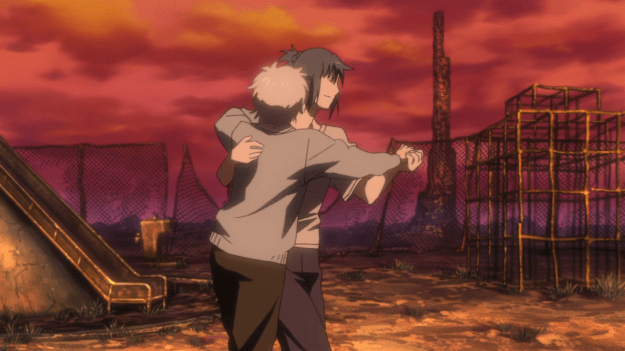

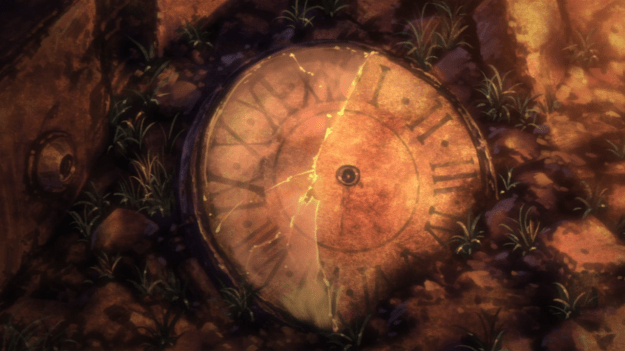









Excellent episode review. Very good job breaking down all of the symbolism in this episode, showing just how rich and multifaceted it all is.
No. 6 continues to impress… but like yourself, I’m worried at how rushed and/or inconclusive the ending may be given that it doesn’t have that many episodes left to work with.
I’m suspecting that the anime will just end on the bee plague destroying No.6 with Shion attempting to rescue his mother, but falling short. I can’t imagine she’ll survive, and I can’t imagine there’s enough episodes for the anime to touch on anything else but the bees.
This was strange and wonderful. Not entirely sure what’s going on with it but between the vision sequence and the dance sequence this episode seems fated to be this series’ pons asinorum.
Agreed that it’s hard to see what kind of satisfying ending the series can get to in the time it has available. The problems of No. 6’s world are too big to be solved so the most that can realistically be hoped for is a resolution to the bee situation and some kind of reunion for Shion and Safu/his mom, I think.
Stray Observations:
Hamlet: putting Nezumi in as Ophelia is interesting in itself. FWIW, the Japanese translation of Shakespeare they’re using seems to be pretty “flat”, cutting it down to a more basic lover rejection. EG: the “get thee to nunnery!” part is basically just “get out!”. The subs are restoring the actual lines from Shakespeare but I’m not sure how much understanding of the original scene’s nuances it’s safe to attribute to the show’s writers.
Dance montage key image: http://i.imgur.com/Bcd2m.jpg (dancing on a cliff!).
Dance montage: the wrecked playground, wasteland, submerged doll, etc., makes me think the dance montage is happening in Nezumi’s “inner world”, for lack of a better way to put it.
Dialogue with double meanings:
– (1) http://i.imgur.com/T6wBv.jpg (Shion, checking is Nezumi’s OK)
– (2) http://i.imgur.com/90C9R.jpg (Nezumi, explicitly calling back to it)
– (3) http://i.imgur.com/uYtfI.jpg (Nezumi, again, in case you missed (2) time)
…with (1) being a good example of using the surface plot to create scenarios where dialog with layered meanings seems natural / in-place, and (2) and (3) showing up 5+ minutes later as failsafes.
Vision Sequence: I think the black leaves and dead trees are supposed to reference Shion’s vision / the wind sequence in ep1 as well.
Speculation: Shion’s close encounter with the bees has left him with some kind of connection to the bee-mind (or whatever), and now the bee-mind (or whatever) is going after people it can tell Shion cares about (Safu, Nezumi). Who knows.
Speculation: Nos 1-6 are largely similar and mostly “normal”. The weird aspects we’ve been seeing might be restricted to No. 6’s “Chronos” and its associated experiments. Perhaps also No. 6 is making a bid to take over the other numbered cities.
Huh. Well, the scene selection itself is still meaningful, even if the exact lines being used are not. I think the parallels between Nezumi’s two-sided nature, especially concerning sex, and Hamlet’s accusations are too apparent to be merely coincidences. Of course, we also don’t know how far into the future “No.6” occurs so it’s also entirely possible that bits and parts of Shakespeare’s play have ceased to exist.
If I could read the original novels, I guess it would help shed light on a few of the details and possibly explore the choices Bones are making in their adaptation.
Well, I hope I didn’t give the impression that they were literally dancing in an actual wasteland. I’m not sure I’d say it occurs only within Nezumi’s inner mind though, but we’ll see.
That’s a neat observation. An interesting callback in the anime, at least.
This is just a personal preference, but I certainly hope there isn’t a literal hive mind at work. I mean, yeah, it fits into the whole bee theme, but just seems too… out there, I guess?
Well, if the anime’s as short as we’ve heard, there’s no way they can really pull this off with such a heavy focus on the characters so far.
Hamlet: agreed scene selection, choice of play, etc., are all meaningful, and chosen deliberately.
Dance Montage: I didn’t mean to imply they didn’t physically dance. I meant more that having Nezumi lead the dance and then the content of the imagery seemed chosen to show Nezumi’s inner state, and specifically that he’s kinda dead inside (despite his frequent protests that he’s alive, etc.).
Agreed a true hive mind would be pretty weak, The “No. 6 conquers the world” only works in the available time if the bees are also the plan. No point speculating too much though. Next week we cross the half-way mark; at least the Dogkeeper’s still in the picture.
I see what you mean. And yeah, we’ll find out soon enough about the plot.
I didn’t know how to relate Nezumi with his role as Ophelia, but after reading your post I was enlightened. I think the double meaning works amazingly well, and it’s such a huge contrast to how Shion perceives Nezumi. (He threw a fit last episode after all.)
No.5 seems a much better place, doesn’t it? Also, there seems to be a number of different nationalities dwelling in No.5. But then, it’s a university and Safu herself is a student studying abroad. But having an art museum and encouraging creative writing…I do think No.5 is meant to be different. Even the classrooms take on a warmer color scheme.
This was such a great read, this episode really is one of the best so far.
That reminds me of something I failed to mention. If No.6 was so concerned about what its citizens are doing and thinking, e.g. reading the classics, why would it allow its students to study abroad?
This doesn’t make any sense to me either, not yet anyway. But then Safu’s like the ultimate product of No.6.
It’s hard to say; we’re not quite sure how loyal Safu is to No.6. I wouldn’t be surprised if someone like her espoused some unsavory beliefs like the pros of eugenics, however.
I also loved the visual quality of the dancing scene — one detail I particularly enjoyed is the splotches on the doll that to me call to mind the disease running rampant throughout No. 6.
I’m also having some doubts about whether the plot will wrap up in a satisfactory way, and the dual bouts of unconsciousness in particular strikes me as a plot point that could go disastrously wrong if not handled with care, but I can’t fault the episode-by-episode progression of the series.
Oh, that’s cool too. I do love the fact that there are enough visual details that it’s hard to notice them all in a single viewing.
I agree — it’s potentially a little too fantastical for my tastes. If they choose to explain this particular mystery, I just hope it won’t be hamfisted.
Awesome review, dude. I loved the dancing scene in this episode.
I think No. 1-6 are practically the same, except for some minor differences.
I have become convinced by your posts on this show to catch up on it. Thank you.
Woot troll, huh?
I was on my phone and feeling uncreative.